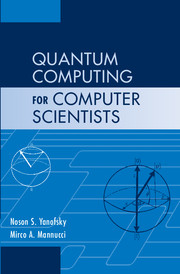Book contents
- Frontmatter
- Contents
- Preface
- Introduction
- 1 Complex Numbers
- 2 Complex Vector Spaces
- 3 The Leap from Classical to Quantum
- 4 Basic Quantum Theory
- 5 Architecture
- 6 Algorithms
- 7 Programming Languages
- 8 Theoretical Computer Science
- 9 Cryptography
- 10 Information Theory
- 11 Hardware
- Appendix A Historical Bibliography of Quantum Computing
- Appendix B Answers to Selected Exercises
- Appendix C Quantum Computing Experiments with MATLAB
- Appendix D Keeping Abreast of Quantum News: Quantum Computing on the Web and in the Literature
- Appendix E Selected Topics for Student Presentations
- Bibliography
- Index
7 - Programming Languages
Published online by Cambridge University Press: 05 June 2012
- Frontmatter
- Contents
- Preface
- Introduction
- 1 Complex Numbers
- 2 Complex Vector Spaces
- 3 The Leap from Classical to Quantum
- 4 Basic Quantum Theory
- 5 Architecture
- 6 Algorithms
- 7 Programming Languages
- 8 Theoretical Computer Science
- 9 Cryptography
- 10 Information Theory
- 11 Hardware
- Appendix A Historical Bibliography of Quantum Computing
- Appendix B Answers to Selected Exercises
- Appendix C Quantum Computing Experiments with MATLAB
- Appendix D Keeping Abreast of Quantum News: Quantum Computing on the Web and in the Literature
- Appendix E Selected Topics for Student Presentations
- Bibliography
- Index
Summary
The computer programmer is a creator of universes for which he alone is the lawgiver … universes of virtually unlimited complexity can be created in the form of computer programs. … They compliantly obey their laws and vividly exhibit their obedient behavior. No playwright, no stage director, no emperor, however powerful, has ever exercised such absolute authority to arrange a stage or a field of battle and to command such unswervingly dutiful actors or troops.
J. Weizmann, Computer Power and Human Reason: From Judgement to CalculationIn this chapter we are going to describe quantum programming, i.e., the art and science of programming a quantum computer. In Section 7.1, we briefly sketch what it means to program a quantum computing device. Section 7.2 covers a simple version of quantum assembler, based on the so-called QRAM architecture. Section 7.3 describes possible steps leading to higher-level programming languages and constructs. We conclude this chapter with Section 7.4, a short discussion on quantum emulators.
PROGRAMMING IN A QUANTUM WORLD
As you are about to read this chapter, you have undoubtedly been exposed to computer programming in a variety of flavors, and are perhaps already an accomplished programmer of real-life applications. Programming a classical machine carries an immediate, unambiguous sense. However, we are going to leave the familiar world of binary chips, and learn how to program some as yet unspecified quantum hardware.
Information
- Type
- Chapter
- Information
- Quantum Computing for Computer Scientists , pp. 220 - 238Publisher: Cambridge University PressPrint publication year: 2008
